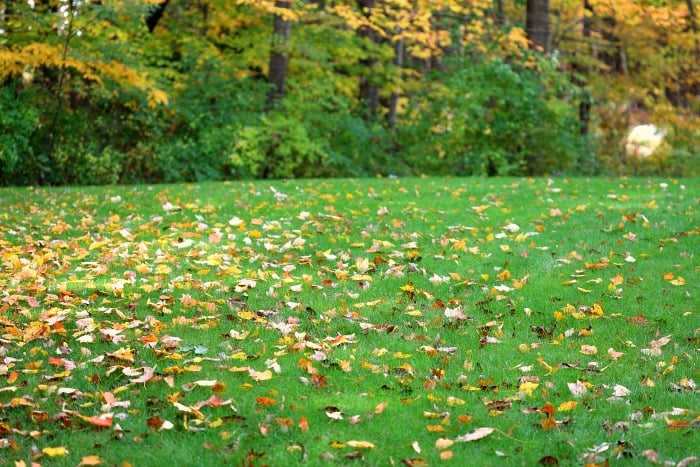A healthy lawn in spring starts in the fall. Follow these fall lawn care tips to successfully overwinter your lawn and watch it surge with green growth in the spring.
Cool season lawns and warm season lawns have to be treated a little differently during fall. Check out these fall lawn care tips for both cool season, and warm season lawns.
Fall Lawn Care Tips for Cool Season Lawns
1.) Decrease Mowing Height Gradually
As fall progresses you want to gradually decrease your mowing height, leaving your last mow of the season as your shortest cut. This will prevent grass from matting during the winter months, and will help prevent snow mold. Mowing shorter in the fall also improves air flow and overall surface conditions.
2.) Remove Leaves
Leaves block light, block air flow, and trap moisture. These are bad conditions for your lawn, so be sure to clean leaves off your lawn areas as often as possible. If you choose to mulch your leaves into your lawn instead of removing them, make sure you go over the lawn several times with the mower. Mulching your leaves back into your lawn can be ok but only if they are very fine so they can decompose quicker.
3.) Stay off Frost Covered Lawn
When your lawn is covered in frost, stay off of it. Wait until the frost burns off in the late morning hours before mowing or even just walking on it. Walking on a frost covered lawn can break the leaf blades and cause frost damage.
4.) Spot Treat Weeds
Spot treating perennial lawn weeds such as clover and dandelions is a great thing to do in the fall and is often overlooked.
These perennial lawn weeds will come back strong in the spring if not dealt with in the fall.
5.) Adjust Irrigation
Fall is usually the time for a change in how you irrigate your lawn. Cooler soil temps and decreased sunlight means you should be able to back off a little on irrigating. Just keep a watch out for those random warm spells that can pop up.
The only exception to decreasing irrigation during the fall is after you fertilize or if you are trying to get seed to germinate. It is important to irrigate during both these times.
6.) Apply Fall Fertilizers
Fertilizing cool season lawns during the fall is very important.
With the heat of the summer gone, a lot of lawn weeds are starting to die back and your lawn is becoming dominant.
Take advantage of these conditions by feeding your lawn with a good nitrogen fertilizer such as Flagship 24-0-6.
When it’s time for your Winterizer fertilizer (the last fertilizer application of the season), you’ll want to pick a fertilizer that has quick release nitrogen, and usually some potassium. But it’s the nitrogen that is most important.
7.) Adjust Soil pH
If you need to increase the pH of your soil, then fall is one of the best times to Lime Your Lawn. Only apply lime if it’s necessary.
Your lawns soil should have a pH of about 6-7. If your lawns pH is lower then 6 adding lime will increase pH to a healthier range.
If your lawn is too alkaline, and you need to lower the pH then Add Sulfur in the fall.
The only real way to know the pH of your lawn is by doing a simple soil test.
8.) Core Aerate/Overseed
Core aerating and overseeding is one of the best ways to turn around a struggling lawn.
If your lawn took a bit of a beating this past year then check out this core aerating/overseeding instructional to get it back on track.
9.) Top Dress Lawn
If you want to seriously make improvements to your lawn, then top dressing is your answer.
In fact, for the ultimate lawn renovation, combine core aeration and overseeding with topdressing. This is the best way to completely renovate your lawn without having to start over.
10.) Dethatch
If you suspect your lawn has a thatch problem, then dethatching is a must. Early fall is the best time to address thatch problems. Check out this complete guide on how to tell if you have a thatch problem and what to do about it: Lawn Dethatching: Everything You Need to Know
11.) Apply Grub Killer If You Have Grubs
There are 2 different ways to deal with grubs. One is by using a preventative chemical and the other is by using a chemical that kills grubs that are actively feeding on your lawn.
Once fall hits, grubs go to the root system of your lawn to feed. At this point, preventative chemicals are pointless, but the chemicals that kill grubs that are actively feeding will make a big difference. These products usually say something like “kills grubs within 24 hours” right on the bag.
For more on grub prevention and treatment check out: White Grubs: Prevention and Treatment
Fall Lawn Care Tips for Warm Season Lawns
For warm season grasses such as Zoysia, Bermuda, St. Augustine, and Centipede, cooler temps signal it’s time to slow growth and prepare for dormancy. Unlike cool season grasses, warm season grass thrives in the summer months and begins to wind down for the year when fall arrives.
1.) Discontinue Fertilizing with Nitrogen
As the cooler temperatures approach and your warm season lawn heads into dormancy, stop fertilizing with Nitrogen. Dormancy for warm season lawns is normal in certain areas that have cooler winters. Fertilizing with nitrogen encourages blade growth and can cause stress since blade growth should naturally be slowing down. Instead, use fertilizers that are high in potassium. This helps your grass when it is heading into dormancy.
2.) Don’t Dethatch or Core Aerate
Dethatching and core aerating should only be done when your lawn is actively growing, or right before it starts actively growing. After dethatching and overseeding, your lawn will have lots of bare spots.
These bare spots will fill in as long as the grass is actively growing. For warm season lawns this is late spring through the summer. These are much better times for core aeration and dethatching.
3.) Spot Treat and Apply Pre-emergent for Winter Weeds
In fall when southern lawns start to cool back down to a soil temp of 70 degrees, they are vulnerable to attack from cool season weeds. Applying a pre-emergent herbicide when soil temps head back down to 70 degrees will help prevent weeds from emerging throughout the fall and winter months.
For any weeds that do emerge, spot treat using a post-emergent liquid herbicide.
4.) Clean Leaves
Clean leaves off of lawn areas to maximize air flow and prevent disease and fungus.
5.) Keep Irrigating
You can usually back off a little, but make sure you keep irrigating. This may seem backwards since the top of your lawn will be brown and dormant, but underneath the soil is not dormant. The roots still require water to remain healthy.
6.) Adjust Lawn pH
Just like cool season lawns, the fall is a great time to either increase the pH of your soil with lime, or decrease the pH with sulfur.
7.) Optional Overseeding With Ryegrass
There is a strategy that some people with warm season grasses use to get a green lawn during the winter months. Since warm season grasses go dormant due to the cold temps, they overseed using either perennial rye grass or annual rye grass.
Since the rye grass is a cool season grass it will thrive during the winter months in southern regions and go dormant, or completely die back, when the hot temperatures arrive and the warm season grasses out compete the rye grass.
This strategy is a little controversial. Some people have great success with it while others complain it’s damaging to their warm season lawn and their lawn never truly converts back to the warm season grass. For more info about this strategy check out the link: Warm Season Lawn Overseeing With Rye
Check Out These Posts Next
Top Dressing Lawn: Benefits and Advice
Lime Your Lawn: A Complete Guide
Lawn Dethatching: Everything You Need to Know
White Grubs: Prevention and Treatment
Follow Me
Join my free email list!
Plus, follow me on Facebook, Instagram, and Pinterest.



A lot of great tips for the lawn. Mowing one last time is so important to keep from getting snow mold in the lawn.
I like what you said about sweeping the leaves off frequently. I need to get a landscaper for the backyard path. I want stones laid down.
Thanks Tex, definitely help with air flow which is so important. Good luck with the stones!
Hi
How many lbs sulphur per 1,000 sq feet, should I add to a lawn with a ph of 8?